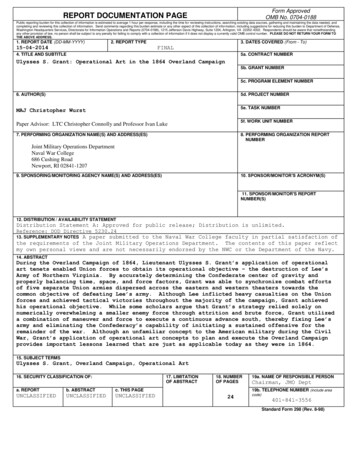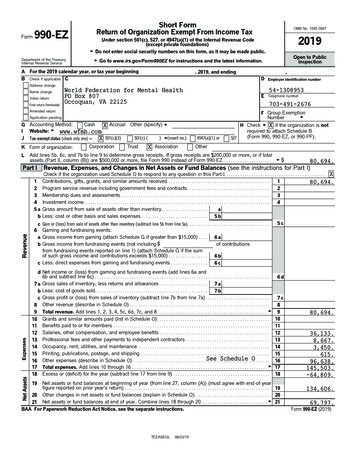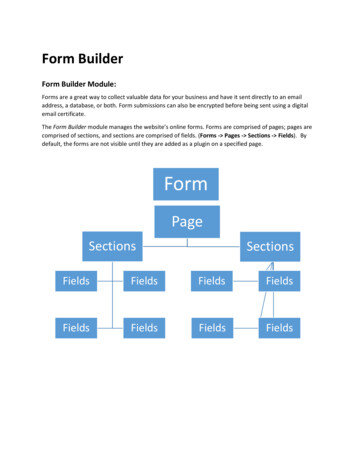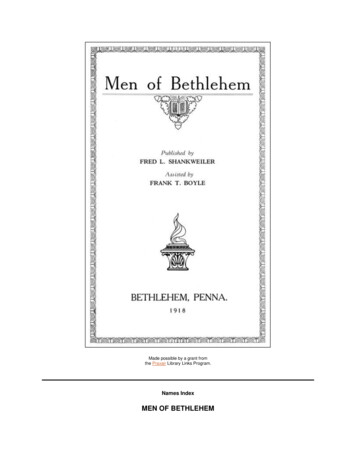
Transcription
Form ApprovedOMB No. 0704-0188REPORT DOCUMENTATION PAGEPublic reporting burden for this collection of information is estimated to average 1 hour per response, including the time for reviewing instructions, searching existing data sources, gathering and maintaining the data needed, andcompleting and reviewing this collection of information. Send comments regarding this burden estimate or any other aspect of this collection of information, including suggestions for reducing this burden to Department of Defense,Washington Headquarters Services, Directorate for Information Operations and Reports (0704-0188), 1215 Jefferson Davis Highway, Suite 1204, Arlington, VA 22202-4302. Respondents should be aware that notwithstandingany other provision of law, no person shall be subject to any penalty for failing to comply with a collection of information if it does not display a currently valid OMB control number. PLEASE DO NOT RETURN YOUR FORM TOTHE ABOVE ADDRESS.1. REPORT DATE (DD-MM-YYYY)2. REPORT TYPE15-04-20143. DATES COVERED (From - To)FINAL4. TITLE AND SUBTITLE5a. CONTRACT NUMBERUlysses S. Grant: Operational Art in the 1864 Overland CampaignOverlandCampaic5b. GRANT NUMBER6. AUTHOR(S)5d. PROJECT NUMBERMAJ Christopher Wurst5e. TASK NUMBER5c. PROGRAM ELEMENT NUMBER5f. WORK UNIT NUMBERPaper Advisor: LTC Christopher Connolly and Professor Ivan Luke7. PERFORMING ORGANIZATION NAME(S) AND ADDRESS(ES)AND ADDRESS(ES)Joint Military Operations8. PERFORMING ORGANIZATION REPORTNUMBERDepartmentNaval War College686 Cushing RoadNewport, RI 02841-120710. SPONSOR/MONITOR’S ACRONYM(S)9. SPONSORING/MONITORING AGENCY NAME(S) AND R'S REPORTREPORTNUMBER(S)12. DISTRIBUTION / AVAILABILITY STATEMENTDistribution Statement A: Approved for public release; Distribution is unlimited.Reference: DOD Directive 5230.24A paper submitted to the Naval War College faculty in partial satisfaction ofthe requirements of the Joint Military Operations Department. The contents of this paper reflectmy own personal views and are not necessarily endorsed by the NWC or the Department of the Navy.13. SUPPLEMENTARY NOTES14. ABSTRACTDuring the Overland Campaign of 1864, Lieutenant Ulysses S. Grant’s application of operationalart tenets enabled Union forces to obtain its operational objective – the destruction of Lee’sArmy of Northern Virginia. By accurately determining the Confederate center of gravity andproperly balancing time, space, and force factors, Grant was able to synchronize combat effortsof five separate Union armies dispersed across the eastern and western theaters towards thecommon objective of defeating Lee’s army. Although Lee inflicted heavy casualties on the Unionforces and achieved tactical victories throughout the majority of the campaign, Grant achievedhis operational objective. While some scholars argue that Grant’s strategy relied solely onnumerically overwhelming a smaller enemy force through attrition and brute force, Grant utilizeda combination of maneuver and force to execute a continuous advance south, thereby fixing Lee’sarmy and eliminating the Confederacy’s capability of initiating a sustained offensive for theremainder of the war. Although an unfamiliar concept to the American military during the CivilWar, Grant’s application of operational art concepts to plan and execute the Overland Campaignprovides important lessons learned that are just as applicable today as they were in 1864.15. SUBJECT TERMSUlysses S. Grant, Overland Campaign, Operational Art16. SECURITY CLASSIFICATION OF:17. LIMITATIONOF ABSTRACTa. REPORTb. ABSTRACTc. THIS PAGEUNCLASSIFIEDUNCLASSIFIEDUNCLASSIFIED18. NUMBEROF PAGES19a. NAME OF RESPONSIBLE PERSONChairman, JMO Dept19b. TELEPHONE NUMBER (include area24code)401-841-3556Standard Form 298 (Rev. 8-98)
NAVAL WAR COLLEGENewport, R.I.Ulysses S. Grant: Operational Art in the 1864 Overland CampaignbyChristopher WurstMAJ / ArmyA paper submitted to the Faculty of the Naval War College in partial satisfaction of therequirements of the Department of Joint Military Operations.The contents of this paper reflect my own personal views and are not necessarilyendorsed by the Naval War College or the Department of the Navy.Signature:15 May 2014
ContentsIntroduction1Counterargument3Operational Art5Objective and Center of Gravity6Operational Factors – Space, Time, and Force10Lessons Learned14Conclusion18Selected Bibliography20ii
AbstractDuring the Overland Campaign of 1864, Lieutenant Ulysses S. Grant’s use ofoperational art enabled Union forces to obtain its operational objective – the destruction ofLee’s Army of Northern Virginia. By accurately determining the Confederate center ofgravity and properly balancing time, space, and force factors, Grant was able to synchronizecombat efforts of five separate Union armies dispersed across the eastern and westerntheaters towards the common objective of defeating Lee’s army. Although Lee inflictedheavy casualties on the Union forces and achieved tactical victories throughout the majorityof the campaign, Grant achieved his operational objective. While some scholars argue thatGrant’s strategy relied solely on numerically overwhelming a smaller enemy force throughattrition and brute force, Grant utilized a combination of maneuver and force to execute acontinuous advance south, thereby fixing Lee’s army and eliminating the Confederacy’scapability of initiating a sustained offensive for the remainder of the war. Although anunfamiliar concept to the American military during the Civil War, Grant’s application ofoperational art concepts to plan and execute the Overland Campaign provides importantlessons learned that are just as applicable today as they were in 1864.iii
IntroductionIn the summer of 1864, the Army of the Potomac faced General Robert E. Lee’sentrenched Army of Northern Virginia in the eastern theater. Despite the fact that the Northwas numerically superior in men and supplies, previous generals such as Ambrose Burnside,Joseph Hooker, George McClellan, and John Pope had failed to harness those resources todecisively defeat the Army of Northern Virginia. Appointed the commander of all Unionarmies in March 1864, Lieutenant General Ulysses S. Grant was responsible for planning andexecuting operations to accomplish what three years of war had failed to. To accomplishthis, Grant proposed to: “ take the initiative in the spring campaign, to work all parts of thearmy together and somewhat towards a common center.”1 Twenty years after the Civil War,Grant summarized the 1864 Overland Campaign in his Memoirs: “Soon after midnight, May3rd-4th, the Army of the Potomac moved out from its position north of the Rapidan, to startupon that memorable campaign, destined to result in the capture of the Confederate capitaland the army defending it. This was not to be accomplished, however, without desperatefighting as the world had ever witnessed; not to be consummated in a day, a week, a month,or a single season. The losses inflicted, and endured, were destined to be severe; but thearmies now confronting each other had already been in deadly conflict for a period of threeyears, with immense losses in killed, by death from sickness, captured and wounded; andneither had made any real progress toward accomplishing the final end.” Grant added: “Thecampaign now begun was destined to result in heavier losses, to both armies, in a given time,than any previously suffered; but the carnage was to be limited to a single year, and to1Ulysses S. Grant, Personal Memoirs (New York: The Modern Library, 1999), 375.1
accomplish all that had been anticipated or desired at the beginning in that time. We had tohave hard fighting to achieve this.”2The Overland Campaign was approximately six weeks long and began on 4 May 1864 atthe Battle of the Wilderness (5-7 May) and ended with the commencement of the Siege ofPetersburg on 15 June. Engagements within the campaign included Spotsylvania (8-21May), North Anna (23-26 May), and Cold Harbor (31 May-12 June). Each tacticalengagement in the campaign proved to be a draw or in favor of the Confederates, but this didnot deter Grant from continuing to maneuver Union forces southeast, attempting to turnLee’s right flank to get in between Lee’s army and Richmond. Lee anticipated Grant’sflanking attempts, and was able to establish defensive positions prior to each battle.However, after the battle at Cold Harbor, Grant maneuvered a final time and surprised Leeby stealthily crossing the James River and marching well south of Richmond towardsPetersburg. With no reinforcements available and Confederate armies engaged across theentire theater, the resulting ten-month Siege of Petersburg led to the eventual surrender ofLee’s army in April 1865.Although not yet recognized as a link between strategy and tactics by the Americanmilitary during the Civil War, Grant’s application of operational art concepts to plan andexecute his Overland Campaign provides important lessons learned that are just as applicabletoday as they were in 1864. Of particular emphasis was Grant’s ability to accuratelydetermine the enemy center of gravity (ECOG) and properly balance factors across force,space, and time to accomplish the operational objective of destroying Lee’s Army of2Ibid., 401.2
Northern Virginia. In stating the destruction of Lee’s army, Grant’s intention was not itsliteral annihilation; but rather, compelling its surrender.3The scope of this paper will encompass the planning and execution of the OverlandCampaign, beginning with Grant’s assumption of command of all Union armies on 4 March1864, to the initial Battle of the Wilderness on 4 May 1864, and finally to the initiation of theSiege of Petersburg on 15 June 1864. The focus will remain on Grant and Meade’s summeroffensive against Lee, but supporting operations by Major Generals Franz Sigel, NathanielBanks, Benjamin Butler, and William Tecumseh Sherman are mentioned briefly to showhow they supported Grant’s operational objective.Counterargument – Attrition through Numerical SuperiorityThere are some scholars who argue that Grant’s strategy during the Overland Campaignrelied solely on numerically overwhelming a smaller enemy force through attrition and bruteforce. Lee’s former adjutant, Walter H. Taylor commented that: “It is well to bear in mindthe great inequality between the two contending armies, in order that one may have a properappreciation of the difficulties which beset General Lee in the task of thwarting the designsof so formidable an adversary, and realize for paucity of numbers, and proved more than amatch for brute force, as illustrated in the hammering policy of General Grant.”4 EdwardPollard, editor of the Richmond Examiner and author of one of the earliest Southern historiesof the war, The Lost Cause (1866), wrote of Grant: “ he contained no spark of militarygenius; his idea of war was to the last degree rude – no strategy he had no conception of3Russell F. Weigley, A Great Civil War: A Military and Political History, 1861-1865 (Bloomington: IndianaUniversity Press, 2000), 328.4Walter H. Taylor, General Lee: His Campaigns in Virginia, 1861-1865 (Lincoln: University of NebraskaPress, 1906), 230-231.3
battle beyond the momentum of numbers.”5 Lee, possessing little respect for Grant’smilitary capabilities, posed contemptuous criticism of Grant in a letter to his son, Custis. Leewrote: “His talent and strategy consists in accumulating overwhelming numbers.”6 NewYork Times war correspondent William Swinton wrote in his Campaigns of the Army of thePotomac (1866) that Grant: “ hoped at one blow to finish the troublesome, and seeminglyinvulnerable, adversary he made little account of those arts that accomplish results by thedirection and combination of forces; for at this period he avowedly despised maneuvering.His reliance was exclusively on the application of brute masses, in rapid and remorselessblows ”7While numerical superiority certainly played a factor in Grant’s ability to maintain arelentless offensive against Confederate forces, such criticism of his military capabilitiesdismisses the balancing advantages that Lee’s army possessed and detracts from Grant’saccomplishments. Acknowledging that resources and numerical strength of the Confederacywere inferior to that of the Union, Grant described in his Memoirs the equalizing advantagesLee possessed: “He was on the defensive, and in a country in which every stream, everyroad, every obstacle to the movement of troops and every natural defense was familiar to himand his army. The citizens were all friendly to him and the cause, and could and did furnishhim with accurate reports of our every move. Rear guards were not necessary for him, andhaving always a railroad at his back, large wagon trains were not required. All circumstances5Mark Grimsley, And Keep Moving On: The Virginia Campaign, May-June 1864 (Lincoln: University ofNebraska Press, 2002), 236.6John William Jones, Life and Letters of Robert Edward Lee: Soldier and Man (New York and Washington:The Neale Publishing Company, 1906), 307.7William Swinton, Campaigns of the Army of the Potomac (New York: Charles Scribner’s Sons, 1882), 439440.4
considered we did not have any advantage in numbers.”8 If it was simply numericalsuperiority, then Lee, who had always fought outnumbered, should have been beaten early onin the war.9 Numerical superiority was not an assurance of victory, as it provided littleadvantage to previous Union generals. It was Grant’s use of operational art tenets and hiswillingness to use the army for its intended purpose – to fight, which allowed Grant to movethe Union towards complete victory.Operational ArtTo understand how Grant incorporated operational art tenets into his planning process,one must understand what operational art is. Milan Vego, a professor and military theorist inthe Joint Military Operations Department at the Naval War College, defined operational artas the: “Component of military art concerned with the theory and practice of planning,preparing, conducting, and sustaining campaigns and major operations aimed ataccomplishing strategic or operational objectives in a given theater.”10 For Grant,operational art was the understanding that the war could not be won with a single, decisivevictory; a realization he acknowledged early in the war during his engagements in the west.Instead, victory would require the synchronization of multiple tactical actions across anentire theater that together would achieve the operational objective. Furthermore, ColonelJohn F. Meehan III, a former Director of Theater Operations at the US Army War Collegewrote in Parameters that the essence of operational art is the employment of one’s militaryforces to accomplish strategic objectives primarily by: “the identification of the enemy’s8Grant, Personal Memoirs, 471.9Grimsley, And Keep Moving On, 16.10Milan N. Vego, Joint Operational Warfare: Theory and Practice (Newport: Naval War College, 2007), I-4.5
Center of Gravity and the single minded focus on the sequence of actions necessary toexpose and destroy it ”11James J. Schneider, a senior faculty member of the School of Advanced Military Studies,maintains that with the capability of distributing forces across an entire theater, the birth ofoperational art occurred in April 1864 during the planning of Grant’s Overland Campaign,whereby Grant planned a campaign consisting of two major operations, with Sherman andBanks in the west; and Meade, Butler, and Sigel in the east.12 Since previous Union generalshad access to the same technologies and troop strength as Grant, what set him apart? Prior tocommanding all Union armies, Grant demonstrated his military capabilities in every gradefrom regimental to departmental command,13 and was never pushed into command until hegained sufficient experience and was prepared for it.14 Much of what set Grant apart fromother Union generals was derived from his battlefield experiences in the western theater,where he had an opportunity to hone his ability to focus on an objective and create anacceptable balance of the operational factors of space, time, and force in order to achieve thatobjective. Most notably, Grant’s capture of Vicksburg demonstrated Grant’s maturingapplication of operational art tenets.Objective and Center of GravityIn choosing an operational objective, a commander acknowledges that achieving theobjective requires the completion of multiple, simultaneous tactical objectives. Linking an11John F. Meehan, III, “Operational Trilogy”, Parameters vol. XVI, no. 3 (1986): 15.12James J. Schneider, “The Loose Marble – and the Origins of Operational Art.” Parameters, (March 1989):92.13T. Harry Williams, McClellan, Sherman, and Grant (Chicago: Elephant Paperbacks, 1962), Kindle edition,101.14Ibid., 89.6
operational objective to a corresponding COG focuses commanders’ planning efforts. Vegodefines COG “as a source of massed strength – physical or moral – or a source of leveragewhose serious degradation, dislocation, neutralization, or destruction would have the mostdecisive impact on the enemy’s or one’s own ability to accomplish a given political/militaryobjective.”15 When planning a campaign or major operation, it is critical to identify thefriendly center of gravity (FCOG) so that it can be protected, and the enemy center of gravity(ECOG) so that it can be defeated. Properly identifying the ECOG ensures the properapplication of the principles of objective, mass, and economy of effort.16Prior to 1864, the operational objective of the Union was to capture the Confederatecapital of Richmond, with the belief that the war would end shortly thereafter. This was notan absurd strategy, since the American army had done just that fifteen years earlier during theMexican War, when the war came to an end upon American forces occupying Mexico City.Unfortunately, had Union forces captured Richmond earlier in the war, the Confederateswould have simply established a capital elsewhere.17 The British made this same mistakeduring the Revolutionary War when they believed the capture of large cities such asCharleston and New York, or even the nominal capital of Philadelphia would force thecolonists to capitulate. Believing that Grant’s predecessors had mistakenly viewedgeographic locations as their objectives, Badeau wrote: “This was a view of the situationwhich Grant’s predecessors in chief command had failed to grasp. Most of the nationalgenerals in every theater, prior to him, had attempted to carry on their operations as if they15Vego, Joint Operational Warfare, VII-13.16Ibid.17J.F.C. Fuller, Grant and Lee: A Study in Personality and Generalship (Bloomington: Indiana UniversityPress, 1957), 41.7
were fighting on foreign fields. They sought to out-maneuver armies, to capture posts, to winby strategy pure and simple. But this method was not sufficient in a civil war.”18 WhereasGrant’s predecessors had been concerned with maneuver, Grant knew that seizing a citymeant nothing with Confederate armies still in the field. Grant’s operational objective thusbecame the destruction of the military power of the rebellion, specifically Lee’s Army ofNorthern Virginia. Destruction of the Army of Northern Virginia would further facilitateachievement of the Union’s strategic objective – the unconditional surrender of the South, asthere would no longer be a Confederate force capable of further military resistance.By identifying the destruction of Lee’s army as the operational objective and ECOG,he could concentrate all available forces towards the primary strength of the rebellion, ratherthan wasting resources on peripheral objectives. He was the first commander to unify theoperations of all five Union field armies and focus all efforts towards a single objective.Before that field commanders acted independently. After his bloody engagement at Shiloh in1862, Grant understood that the Union would have to destroy everything that could be usedto support or supply the Confederate armies in order to defeat the rebellion,19 which heavilyinfluenced his decision-making process for the remainder of the war.To attack the ECOG, Grant planned for two simultaneous offensives in the westerntheater. Sherman, who was to move his armies from Chattanooga to Atlanta, would lead thefirst offensive. His primary objective was to destroy General Joseph E. Johnston’s Army ofTennessee, and his intermediate objective was the capture of Atlanta, an industrial and railhub of the South. Banks was to assist Sherman by capturing Mobile, one of only two ports18Adam Badeau, Military History of U.S. Grant, Volume III (New York: D. Appleton and Company, 1881),643.19Grant, Personal Memoirs, 194.8
still in Confederate possession. Banks was then to approach Johnston’s army in the rear,while Sherman approached from the front.20 Ultimately, the primary intent of the westernoperations was to preclude Johnston, the other main Confederate army, from reinforcing Lee,and vice-versa.In the east, Grant planned three simultaneous offensives. First, Grant instructed Meadethat: “Wherever Lee goes, there you will go also.”21 Next, to support Meade, Sigel was tomove through the Shenandoah Valley to destroy the Virginia and Tennessee Railroad, a keysupply route for the Confederacy, and also prevent a northern invasion through the valley.22Finally, Butler was to advance up the Peninsula via the James River, with Richmond andPetersburg as his objective.23 Grant made it clear what the collective objective was when hespoke to his staff the night before the campaign began: “ I want all commanders to feel thathostile armies, and not cities, are to be their objective points.”24Although the offensives by Banks, Butler, and Sigel ultimately proved to be failures, thesynchronized offensives nevertheless put additional pressure on the Confederates anddiverted strength away from the main Union armies of Sherman and Meade. As Lincolnwould say: “ if a man can’t skin he must hold a leg while somebody else does.”25 Byleveraging cumulative tactical effects between the eastern and western theaters, Grant wasable to prevent the shifting of forces between Lee’s Army of Northern Virginia and20Fuller, Grant and Lee, 208.21Grant, Personal Memoirs, 378.22Ibid., 375.23Ibid., 376.24Horace Porter, Campaigning with Grant (New York: The Century Co., 1907), Kindle edition, 35.25Grant, Personal Memoirs, 381.9
Johnston’s Army of Tennessee, thus degrading Lee’s forces to the point where he was forcedto surrender.Operational Factors – Space, Time, and ForceOperational factors are the variables with which all operational commanders mustseek to balance as much as possible in order to successfully accomplish a military objective,by identifying the right force to employ at the right place at the right time. Since lost timecan never be regained, it should serve as the central factor from which planningconsiderations derive.26 When Grant assumed command of all Union armies, he wasimmediately faced with several time-related challenges that instilled a sense of urgency in hisdecision making cycle. With the presidential election in November 1864, the possibility offoreign intervention (England and/or France), three-year enlistments set to expire, andwaning Northern support for the war, Grant was under pressure to secure a quick win, andonly had eight weeks from the time he assumed supreme command to plan a campaign to doso.One of the ways Grant attempted to balance the factors of space-time was to apply aninnovative operational idea that accelerated the time in which an operation occurs.27 Fromthe start of the campaign until the siege initiation six weeks later, there were only a few dayswhere the two armies were not engaged. The continuous and uninterrupted combat wasdifferent from the previous tempo and intensity experienced by either side during the war.Previously, a battle or engagement would last for a few days, followed by a long period of26Vego, Joint Operational Warfare, III-51.27Ibid., III-57.10
inactivity where the armies would rest and replenish supplies. After the second day at theBattle of the Wilderness, Union forces had sustained heavy casualties. Instead of Grantwithdrawing his forces to lick its wounds, he ordered the soldiers to continue moving southin an attempt to turn Lee’s left flank, which he would continue several more times untilreaching Petersburg. With that order, Grant had changed the conduct of the war. Bymaintaining a high tempo Grant was attempting to achieve victory in the quickest amount oftime, thereby protecting the strategic FCOG – Northern popular support for the war. Thelonger the war dragged on, the less likely the North was willing to support it.28 Because thegeography of the eastern theater limited maneuver, Grant was correct in quickly engagingLee’s army so that Union attacks were conducted against hastily constructed entrenchments.Had Lee’s army had additional time to reinforce their entrenchments, or even worse, towithdraw into Richmond and fortify its defenses, the war would have been prolonged.To balance the factors of space-force, Grant desired to increase the numerical size ofhis forces29 so that he would be able to: “ concentrate all the force possible against theConfederate armies in the field.”30 Despite achieving numerical superiority, Grant was stillfaced with the challenge of concentrating superior combat power across a vast area. MajorGeneral JFC Fuller, an innovative British army officer, military theorist and historian, wrotethat: “The strategic strength of the Confederacy lay in its size and also in its lack ofcommunications, for its conquest demanded its entire occupation, and how to effect thisoccupation was the outstanding military problem of the Federal Armies.”31 Another problem28J.F.C. Fuller, The Generalship of Ulysses S. Grant (Bloomington: Indiana University Press, 1977), 366.29Vego, Joint Operational Warfare, III-51.30Grant, Personal Memoirs, 374.31Fuller, Grant and Lee, 41.11
Grant encountered was that the geography of Virginia limited maneuvering space to a narrowstrip between the Allegheny Mountains and the Chesapeake Bay, and the majority of riversand streams ran west to east, presenting a natural barrier to north-south movement.32 Inaddition, much of the terrain was heavily wooded and most dirt roads were narrow andbecame quagmires in the rain.33 Critics question why Grant did not utilize the navy to bypassthe difficult terrain and approach Richmond from the south, similar to the goal ofMcClellan’s Peninsula Campaign. At President Abraham Lincoln’s insistence, Grant wasobliged to keep his forces between Lee and the Federal capital to prevent further incursionsnorth,34 so maritime maneuver was not an option. Also, Richmond was not the objective;Lee’s army was. In order to achieve the stated objective, Grant had to maneuver his forcesoverland, engaging Lee’s army as necessary in an attempt to force him from hisentrenchments to fight in the open, where Union numerical superiority and firepower wouldthen have an advantage.Another technique to balance the factors of space-force is to employ naval forces toprovide logistical supplies and establish forward bases.35 While Grant did not utilize amaritime route to maneuver his forces closer to Richmond, he did take advantage of the seato maintain the stream of supplies that were necessary to sustain the large Northern armiesduring the campaign. Proximity to the coast was the primary reason Grant ordered Meade tomove south against Lee’s right flank, instead of his left flank, where the terrain was moreopen and advantageous for maneuver. By maneuvering on Lee’s right flank and staying as32Grimsley, And Keep Moving On, 4.33Grant, Personal Memoirs, 373, 403, 405.34Grimsley, And Keep Moving On, 82.35Vego, Joint Operational Warfare, III-51.12
close to the coast as possible, Grant utilized the navy to change his base of supply at will.Utilizing the sea as a supply route also limited the number of soldiers that would normally berequired to protect the line of supply.36 Grant effectively leveraged the Union navy’s seacontrol to maintain a continuous supply network and shift his operations closer to the enemy,thus shortening his lines of operation.The composition and size of a force will affect how a commander balances the factorsof time-force.37 Although the Union did retain a larger number of forces, there wereweaknesses in the composition and size of that force that created challenges for Grant. Thefirst challenge was that three-year Union enlistments were set to expire in the summer of1864. At least a dozen regiments were scheduled to leave the army in July.38 Of the totalUnion enlistments set to expire, approximately 136,000 veterans reenlisted and another100,000 did not. For the soldiers that did not reenlist, they became increasingly averse todanger during the final weeks of their enlistments, which limited their combat potential andlowered the morale of the soldiers that did reenlist. This posed impediments during thesummer period when fighting was at its heaviest. In addition, the quality of soldiers thatreplaced the wounded, killed, or discharged was questionable as a Federal draft was initiatedin the spring of 1864, and as desertions increased, Grant complained that: “out of five reportNorth as having enlisted we don’t get more than one effective soldier.”39 Knowing thepotential effects of the upcoming presidential election and that many enlistments were set toexpire, Grant was under pressure to achieve victory as soon as possible.36Fuller, Grant and Lee, 209.37Vego, Joint Operational Warfare, III-59.38James McPherson, Battle Cry of Freedom (New York: Oxford University Press, 1988), 734.39Ibid., 720.13
Finally, balancing the factors of space-time-force is the most difficult aspect inplanning a campaign because rarely, if ever, will a comman
Form Approved OMB No. 0704-0188 Public reporting burden for this collection of information is estimated to average 1 hour per response, including the time for reviewing instructions, searching existing data sources, gathering and maintaining the data needed, and completing and reviewing this collection of information.











